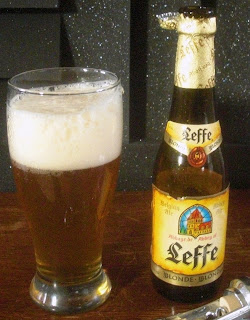It's been too long since last we drank. So let's get to it!

This week we have Leffe Blonde. A Belgian "Abbey" Ale which tries it's best to take us back to the time when clergymen in funny white robes brewed fantastic beer. The only confusing bit comes when you read the history of the brand, which is named after Notre Dame de Leffe, A monastery founded in 1152 on the Meuse River in the province of Namur in southern Belgium. Not confused yet? Well the bottle reads "Anno 1240"... Maybe that's when they started brewing right? Well, tough call, Abbey brewing was already a strong tradition at the time, and there's no telling when exactly they decided to get down to business, what we do know is that in 1460 it was destroyed by a flood. Then a fire in 1466. But the brewery part was pretty much okay... until it was attacked by billeted troops in 1735. Then completely destroyed in the French Revolution in 1794. It's okay though, all the funny robed men came back around 1902.
In 1952 a Flemish based brewery partnered up with the Abbey to start crankin' out brew again. This brewery was bought up by, then, InterBrew and was brewed in Mont-Saint-Guibert until all Leffe brands were moved to the Stella Artois brewery in Leuven. You now know InterBrew as international brewery giant InBev (Anheuser-Busch/InBev) But because they left the original 1952 agreement between the Abbey and the Flemish brewers alone, this is a truely unique commercial brew and was the first of its kind to pay royalties to the Abbey (And they continue to be paid.)
So let's pour one up, then!
In 1952 a Flemish based brewery partnered up with the Abbey to start crankin' out brew again. This brewery was bought up by, then, InterBrew and was brewed in Mont-Saint-Guibert until all Leffe brands were moved to the Stella Artois brewery in Leuven. You now know InterBrew as international brewery giant InBev (Anheuser-Busch/InBev) But because they left the original 1952 agreement between the Abbey and the Flemish brewers alone, this is a truely unique commercial brew and was the first of its kind to pay royalties to the Abbey (And they continue to be paid.)
So let's pour one up, then!

Color: The color of this beer is great. Clear but with a dark honey hue. Almost burnt orange just around the head. Could be just a touch foggy, but not cloudy. Just a touch opaque. Good continuous show of "champagne" bubbles, although not as energetic.
Pour: This is an aggressive pour, resulting in a great foamy 3-finger head (It filled my English Pub Glass) The head settled to a lacy film which was well-retained to the end of the glass.
Nose: Very sweet, strong apple tones almost apple juice-like with an almost wheaty thickness settling into a sort of honey scent.
Taste: This is a hard one to nail down. It starts off bitter, almost like a dark ale but then it mellows to almost a cider, with hints of honey and cinnamon. If you let it linger a while longer it brightens up and becomes very citrus-like. It finishes with a warm, sweet tone followed by a lingering bite of hops and spice. The whole flavour seems to change if you take a quick sip as opposed to a long taste, the sweetness and apple-tones are lost in passing and there's only a sort of rich, spicy cider impression.
Feel: Not too thin. Not too thick. The carbonation is there but not overstated, maybe not quite enough if you like your beer fizzy. If what you're looking for is tongue-bite, though, the cider-notes seem to take care of that, it can even be a bit much on the tongue by the end of the glass.
Over-all: This is a great dessert-beer. A little too sweet to drink all of the time, and wouldn't go well with some foods. But as an after-dinner beer, this one could be just what the doctor ordered. It's a bit thick and round for a sweet beer, so if you're used to a thin, fizzy beer you might want to take it slow, it's not unlike eating a piece of cake, a piece of cake served up 1240AD-style at a Belgian Abbey.








